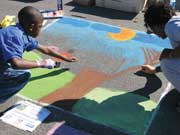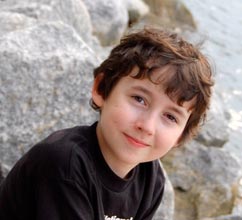By Mary Martha Greene
While planning a recent trip to France, I had the option to stay over a couple of days in Paris on the back end of the trip. I knew I wanted to figure out a way to get to Normandy, to retrace my father‘s– Beaufort’s first family court Judge Felix Greene — route with the 82nd Airborne. I knew Daddy was in a glider regiment but wasn’t entirely sure which one. For some reason, I thought it was the 325th Glider infantry regiment.
I searched online and found complete rosters of the 325th, but Daddy’s name was nowhere to be seen. In frustration one night, as I was trying to go to sleep, I wasn’t so much praying to God as I was talking to Daddy in my head and said “Please just help me figure this out.” The next morning, 319th popped in my head – maybe it was buried in there from long ago, maybe he put it there, I will never know. At any rate, I got up, searched for his name and there it was. A website called “319gliderman.com”, which listed the 319thregiment with the 4 companies attached to it. There was a page for each member of the regiment, I clicked on Daddy’s picture, but nothing else was listed under his name.
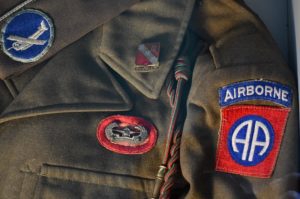
At the bottom of the page was the typical “If you’d like to contact us” link, so I clicked on it and sent a brief email asking for more information about my Dad. Not an hour later, I got a response: “Your Dad is all over the company records, probably mentioned by name and his signature more than any other soldier because he was the Chief Warrant Officer for the division. It would be easier to explain your Dad’s role and the background information about the 319th in a conversation.”
After an exchange of phone numbers, I spent about an hour talking with Bill Bonnamy, whose dad was in the “A” Battery company of the 319th. He’s become the keeper of the history of the regiment and has determinedly tracked down any bit of information about as many of the men that he can find. He sent me some pictures, some of which I’d seen before, some of which I hadn’t. Some of the ones I’d seen I had no idea where they were taken, he filled in a lot of the blanks, and we’ve had an ongoing conversation ever since. He sent me many of the daily reports – signed by my Dad – so I could trace exactly what they were doing from the time they made a very dangerous glider landing on D-day. He also sent me a book, “Battery: C. Lenton Sartain and the Airbourne G. I.’s of the 319th Glider Field Artillery”, which traces the unit from their origins at Camp Claibourne in Baton Rouge, Louisiana until the end of the war and beyond.
The Glider Artillery’s role was to land with the bigger artillery weapons that were not able to be landed in with the paratroopers, and to provide them with artillery support.
Now to figure out how to get there.
The University of South Carolina Alumni Association hosted a breakfast this year on June 6th in commemoration of D-Day and showed clips of the Movietone News collection from photographers embedded with the troops. In seeing those film clips, you wonder how any of them survived the landing, much less were able to fight once they did land. (The clips are available at https://digital.library.sc.edu/collections/fox-movietone-news-the-war-years/ )
Following the program, I spoke with the presenter and curator of the Movietone news collection, Greg Wilsbacher. I told him my Dad was in the 82nd, he replied his great uncle had served in the 101st. We exchanged cards and decided we’d meet to schedule a time to talk more. I met with him several weeks later, and took a trove of Daddy’s maps, pictures, and other information, most written after the battles to recap how many men, how much machinery and other equipment they landed in each battle. The 82nd, and my dad, had already been in the thick of it from 1943 in North Africa, Sicily, and Italy.
To say Greg was less than impressed with my “archival” abilities would be an understatement. It happened to be raining that day – not terribly hard – so the biggest thing I could find to transport the maps and other documents in was a large Krispy Kreme shopping bag that was deep and wide. Greg graciously spent about two hours with me, going through the maps and other items. He wrapped some of the things in archival tissue paper and gave me a rather large archival quality box to start storing them in.
At one point, he asked me to feel the paper of one of the maps. It felt like regular, if somewhat old and crunchy paper. “Now feel this one” he said, holding a different map. I could tell it felt different, more the consistency of a dollar bill. “That paper has more cotton in it, that would have been a map they’d have carried with them into battle, so that if it got wet it wouldn’t disintegrate as easily.” Something I would have never known.
As time got closer for the trip, I knew I wanted to hire a private guide, so that I could spend more time at St. Mere-Eglise, the village where daddy and the 82nd landed. (St. Mere-Eglise also claims the distinction of being the first French town to be freed on D-Day.) Several friends gave me suggestions and older, pre-covid contacts, but Greg came through again and recommended Eva Ruttger. After a few e-emails back and forth and a very early morning of getting to the St. Lazare train station in Paris at 5:00 a.m., she was there to meet me at the train station in Bayeux when I arrived bright and early at 8:45 a.m.
After a quick breakfast and a little planning, we were off for the day. The first stop, along a four lane “superhighway”, as they call their Interstates, was the landing zones of the glider divisions of the 82nd. The fields were divided by the famous hedgerows, combinations of trees and shrubs, often with a ditch on either side. Normandy, being right on the western coast of Europe, is naturally very windy, and the original purpose of the hedge rows was to serve as wind breaks, and to also keep the dairy and beef cows fenced in. The Allies had aerial reconnaissance photos that showed the hedgerows, but from the air you couldn’t tell how tall they were. According to Eva, the French resistance had also warned the planners of the operation about them, but they still underestimated their height and thickness, and the problems they would cause on D-Day and breaking out from the beaches in the following days. Another problem for the glider landings was the Germans had cut trees and placed pointed poles, referred to as “Rommel’s asparagus”, after German Field Marshall Erwin Rommel. These stakes, placed in open fields to tear into the wood and canvas gliders, created an even more hazardous landing zone.
She also pointed out the flood gates contained under bridges that allowed the French to control the tides at various times of the year for agricultural purposes. The Germans put wooden poles in these to keep them open, and flooded the fields surrounding the area, in a further effort to stymie any airborne landings.
After a few pictures of the landing zone, we were back on the road to St. Mere-Eglise, the heart of the 82nd’s landing area. The beautiful church dominates the square, hanging from the steeple is a white parachute and a dummy dressed to represent Private John Steele, who got stuck on the steeple of the church coming down. He was hanging there for most of the battle, but fortunately on the opposite side from where most of the German troops were positioned. There were two German snipers in the steeple, but they were afraid if they fired at him, it would give away their position to an American sniper, so they left him there until the bulk of the battle was over with. The people of St. Mere-Eglise really weren’t aware of Pvt. Steele’s story until the film “The Longest Day” began filming there in 1961.
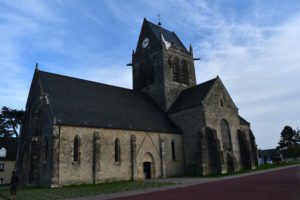
Church at St. Mere-Eglise
The church itself contains many beautiful stained-glass windows, two of which are dedicated to the airborne operations. The first one was dedicated in 1946 and was designed by the son of the mayor of St. Mere-Eglise who was 10 years old at the time of the D-Day landings. It depicts the Virgin Mary and Christ child above a burning Sainte Mere-Eglise with paratroopers and planes descending around her.
The second window, Eva explained, was given by the people of St. Mere-Eglise to commemorate the 25th anniversary of the invasion. It seems that many of the soldiers who participated in the battle did not start returning to Normandy until the 25th Anniversary in 1969. This window depicts Saint Michael, the patron saint of paratroopers and includes the 82nd Airborne Division, the lion of Normandy, and the Saint Mere-Eglise insignia. Symbols for each of the combat jumps made by the 82nd Airborne Division during World War II are also represented in the window. The same artist that designed the first window also designed the second.
Seeing these windows made me realize it must have taken time for the participants of the battle to begin to talk about it and share with their families — I don’t remember Daddy really talking about it, at least not the me, until the 30th Anniversary in 1974, when I was a teenager.
On the opposite end of the square, they have built a museum dedicated to the Airbourne assault. One building houses a glider made from wood and canvas, although apparently the kind of glider Daddy landed in where the British Horsa gliders, made completely out of plywood and thought to be more “secure” Can you imagine? These gliders contained no engine, were towed across the channel by a C-47 some of which had already made one drop previously of paratroopers. The planes delivering the paratroopers flew west to east across the Cherbourg Peninsula, but the gliders had to be going into the wind to get them to slow down enough to land, so they were towed east to west, meaning they had to be towed over Utah beach, were the aerial bombardment was still going on to knock out some of the German Atlantic line defensive positions that still had troops pinned down on the beach. Surviving the crossing was their first challenge, surviving the landing was their next challenge. The planners of the mission, including Gen. Dwight “Ike” Eisenhower and General Omar Bradley expected a 50% casualty rate for the paratroopers and a 70% casualty rate of killed, wounded or seriously impaired in the gliders before their units could assemble on French soil. Thankfully, those rates did not materialize, although looking in the glider and some of the footage from the landings, I realized how lucky my dad was to survive it and how lucky I am to ever have been born.
At the museum, they had a display of the different colors of parachutes that were used in drops. Of course, the paratroopers had camouflage patterned chutes, and their back-up shoots were white. (This is often portrayed wrong in the movies showing them descending with the white chutes.) But they would also drop supplies using a color-coded system of chutes – a red chute indicated ammo, a bright blue chute indicated medical supplies, and yellow was small artillery equipment and ammo such as shells and mortars.
From St. Mere-Eglise, we headed north to see were the 319th established their headquarters on the high ground about the town. On the way, we stopped at a cornfield – it pretty much looked like many of our cornfields on St. Helena Island in the early fall with the brown cornstalks. But a marker explained that on this site they built an airfield. In order for the planes to have something more substantial to land on, the engineers brought in large rolls of what appeared to be squared off chain length fence. They laid them down to build the runway, so that the planes would not get mired down in the mud. Ava showed me a picture of what the runway looked like when it was completed, then she said, “Now turn around and look at that fence.”
Sure enough, if you looked closely at the fence of the adjacent farm, after the war, the farmer had used the leftover landing strip material to rebuild his fence, part of the famous hedgerows, that had been destroyed by the battle. This scene was repeated in numerous locations with sections of the airfield repairing and replacing fences all over the countryside. Reuse and recycle were important to people who had been living under German occupation for 4 years and had very limited resources after the war.
After a look at the site of their HQ, we headed south to the small town of Chef Du Pont, where the 319thprovided artillery support to the 508th paratroopers who were to take and hold the bridge to secure the way for the troops when they could begin moving out from the beaches. The “Battery” book described this in great detail, and there is now a passive park there to commemorate the fierce fighting that took place. The area reminds you a lot of our South Carolina lowcountry, with a meandering stream of water and low, marshy areas. It was incredible to be standing where I knew my father had been, and as a friend of mine put it, “Can you imagine what he’d have said if at that point during that battle someone told him many years in the future he’d have a daughter that came back here to see it all.”
We could have spent the entire day exploring just in and around St. Mere-Eglise, but I also wanted to do justice to the men who’d landed on the beaches, and if they hadn’t taken those beaches, my dad and the airborne troops who’d landed inland would probably have all been captured or killed.
We headed to Pointe Du Hoc, the landing site for the famous Second Ranger Battalion. Standing atop that cliff and looking at the German gun placements they were facing, it is amazing that anyone was able to scale it, much less take out German machine guns once they reached the top. There was also a concrete bunker, that had taken a direct hit from an incoming bomb– the large concrete remains are scattered over the area where the bunker was once housed. It makes you realize the force that was necessary to make the concrete “fly” that far.
Pointe Du Hoc overlooks Omaha beach, so we headed there next. One of the most moving sites is the monument to the boys of Bedford Virginia. Bedford provided a company of soldiers (Company A) to the 29th Infantry Division of the National Guard’s 116th Infantry Regiment and were some of the first to go ashore that morning. The company lost 19 men, and 2 more died later during the battle. The town of Bedford had a population of 2,200 at that time, so proportionally they lost more men than any other town on D-Day. There is a statue to the men of Company A at Omaha Beach, and an identical statue at the National D-Day Memorial, located in their hometown of Bedford. It is a very humbling experience to stand on that beach, or any of the other landing sites, and think about the courage it took for those men to come ashore under withering gun fire and artillery barrages, and to continue to come in waves until they gained a foothold and could break through the enemy lines.
Our last stop of the day was at the Normandy American Cemetery. Set high on a cliff overlooking the landing beaches, you can’t help but be taken aback by row after row of crosses and stars of David. Eva had planned our trip so that we would be there for the retiring of the flags and the playing of taps, an hour before the cemetery closes. The she pointed out the landscaping – oaks, long leaf pines, holly bushes, pyracantha. When the cemetery was being built following the war, they brought over native plants from America, so that the soldiers buried there would be surrounded by the trappings of their home country, a tradition that is still carried on to this day. And the one plant that touched me the most – the purple plumes of sweetgrass plants, which would represent our boys from the Lowcountry who are buried at the cemetery.
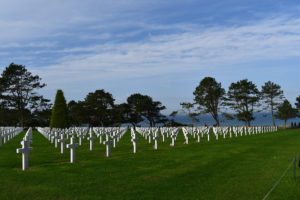
Normandy Cemetery
One of the most moving stories, that began at the original D-Day cemetery near St. Mere-Eglise, was that of Mrs. Simone Renaud, the wife of the mayor of St. Mere-Eglise at the time of the battle. Following the battle but while the war was still going on, Mrs. Renaud began to get letters from the mothers of soldiers who had died and were buried at the original cemetery, asking her if she might put flowers on their sons’ graves. Over time, more and more letters began to arrive. Mrs. Renaud was fluent in English and took it upon herself to answer each of the letters, in a show a gratitude to the soldiers who had given “their last full measure of devotion” as Abraham Lincoln once described those who died for their country.
And remember those different colors of parachutes that were used by the 82nd and other Airbourne units? Mrs. Renaud and other ladies in St. Mere-Eglise began to use the silk in the white, back-up parachutes to sew small bags. They would fill the bags with some of the dirt from the cemeteries where the soldiers were buried and send them to their families thousands of miles away in America, with the gratitude of a grateful France. She continued this act of service for the next 44 years, until her death in 1988. (There is a movie about her called “The Mother of Normandy”, you can view the trailer for the movie on You Tube.)
My Father passed away in 1980, before they were recognized as “The Greatest Generation” by Tom Brokow, before the “Band of Brothers” or “Saving Private Ryan”. About two summers before he died, the movie “A Bridge Too Far” came out, about Operation Market Garden, another famous though less successful battle in which the 82nd played a major role. He talked a little bit about that battle, mostly how much they all hated the British General Bernard “Monty” Montgomery. Oh, how I wish he’d have taken out all those documents that were stored in his study of our house and spread them on his desk to explain to me what they’d done and why it was important. But like a lot of the men who went and fought, he never talked that much about it. They went and did what they were called on to do – to literally save democracy and return freedom to millions of people – but they came home, went back to their jobs, lives and families, and if they thought of their wartime experiences, they rarely if ever spoke of it. Thus it took some research and tracking down his steps to find out more about his wartime service but it was so worth it in the end.
By 9:00 p.m., I was safely back in my hotel in Paris, tired, but happy and with a full heart, having traced my father’s participation in this once in an age battle, and even more respect for him and the others of his generation. I’ve got his maps and papers stored more securely in the archival paper and boxes that Greg Wilsbacher gave me. As we were wrapping up our first meeting back in June, he was looking at the maps and other papers Daddy had brought home from the war. He asked me “Miss Greene, what are your long-term plans for these documents?” I told him I hadn’t really thought about that. I hope someday when I am ready to part with them that the University of South Carolina, both my Dad’s and my Alma Mater, will be interested in adding them to their collection of papers from their graduates. And I hope other families with similar treasures will find places to share them to tell the stories of their hometown heroes who also never talked about their experiences. I think those heroes would all be pleased with that.
Mary Martha Greene is a Beaufort native who has had a 45-year career in lobbying, government relations and grassroots organizing. She is also the author of The Cheese Biscuit Queen Tells All, a cookbook/food memoir published by USC Press. She divides her time between Beaufort and Columbia.


